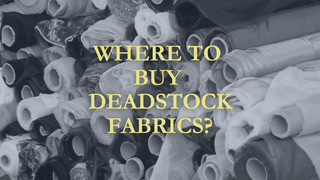Where to buy deadstock fabrics?
The fashion industry is notorious for its waste, with millions of tons of fabric waste ending up in landfills every year. One solution to this problem is to produce upcycled garments using deadstock fabrics. In this post, we’ll explore what deadstock fabrics are, why they’re beneficial for sustainable fashion, and where you can find them.
What are deadstock fabrics?
Deadstock fabrics are surplus materials from textile mills and garment factories that are leftover from production runs and usually kept in warehouses for years. These fabrics can include end-of-roll materials, and discontinued lines also off-cuts and test fabrics are usually considered waste, but can still be saved as well. Instead of being discarded, these fabrics can be repurposed into new garments and products, giving them a second life.
Why use deadstock fabrics?
1. Environmental benefits
Using deadstock fabrics helps reduce textile waste, which is a significant contributor to environmental degradation. By repurposing these materials, we can decrease the amount of waste sent to landfills and reduce the demand for new fabric production, which often involves water-intensive and pollutive processes.
2. Unique and limited edition pieces
Deadstock fabrics often come in limited quantities, making it possible to create unique and exclusive pieces. This exclusivity can be a significant selling point for brands looking to offer something different from mass-produced fashion items.
3. Cost-effectiveness
Deadstock fabrics are typically sold at a lower cost compared to newly produced fabrics. This can be beneficial for small fashion brands and designers who are looking to keep production costs down while still using high-quality materials.
4. Supporting a circular economy
By using deadstock fabrics, designers and brands contribute to a circular economy where resources are reused and recycled. This sustainable practice helps to close the loop in the fashion industry, making it more environmentally friendly and resource-efficient.
Where to find deadstock fabrics
1. Textile mills and factories
One of the best places to source deadstock fabrics is directly from textile mills and garment factories. These facilities often have leftover materials from production runs that they are willing to sell at a discounted rate. Building relationships with these suppliers can provide a steady supply of high-quality deadstock fabrics.
2. Online Marketplaces
Several online platforms specialize in selling deadstock fabrics. Here’s a list of some notable marketplaces from various countries:
- Silk and more: Deadstock fabrics (Italy, Europe)
- Recovo: Deadstock fabrics and low impact materials of the future from top mills and fashion houses (Spain, Europe)
- Nona Source: More than 3000 high-end deadstock fabrics available online: silk, viscose, organza, georgette (France, Europe)
- Zero W: Specializes in leather (Italy, Europe)
- Readymade Textile: Redistributes deluxe deadstock made in Italy fabrics. We curate, catalog, and trade a unique collection of salvaged textiles (Italy, Europe)
- DAMO Studio: A studio that not only can help you find the best sustainable and deadstock materials but also help you with the eco-design of your products.
- EVA Resource: Discover our collection of over 300 luxury deadstock fabrics from renowned fashion houses (Italy, Europe)
- Constrvctor: Collection of the finest Italian deadstock fabrics from world’s top fashion houses and designers. This is B2B wholesale service (Italy, Europe)
- Maeba International: Excellent deadstock fabrics (Italy, Europe)
- Wasted Fabrics: Gives a second life to designers' deadstock fabrics for the great pleasure of sewing enthusiasts, brands (Netherlands, Europe)
- Fabric House: New textiles every week, you can order free sampels. (Germany, Europe)
- Fabric Romance: High quality designer fabrics coming from overproduction, remnants, and deadstock of prestigious fashion brands (Ireland)
- Sew Me Sunshine: High quality designer fabrics coming from overproduction, remnants, and deadstock of prestigious fashion brands (UK)
- Beglarian Fabrics: Access to luxury deadstock fabrics on our online platform, delivering global sustainability with each fabric meter (France, Europe)
3. Fabric stores and wholesalers
Local fabric stores and wholesalers sometimes carry deadstock fabrics but usually very small quantities around 1 or 2 meters, particularly those that focus on sustainable or eco-friendly materials. It's worth visiting these stores and asking about their deadstock inventory, as they might have hidden gems that aren't listed online.
4. Fashion brand partnerships
Some fashion brands sell their leftover fabrics directly to consumers or other designers. Brands committed to sustainability often look for ways to reduce their waste, and selling deadstock fabrics is one such initiative. Keep an eye out for collaborations or partnerships with brands that align with your values.
Conclusion
Deadstock fabrics offer a practical and sustainable solution to the fashion industry's waste problem. By repurposing surplus materials, designers can create unique, cost-effective, and environmentally friendly products. Whether sourced from textile mills, online marketplaces, or local fabric stores, deadstock fabrics are a valuable resource for anyone committed to sustainable fashion.
Embracing deadstock fabrics not only supports a circular economy but also helps to reduce the environmental impact of the fashion industry. By making conscious choices about the materials we use, we can contribute to a more sustainable and responsible fashion future.
Call to Action:
Know more Marketplaces? If you know of other great marketplaces for deadstock fabrics, please let us know in the comments below!
Textile Producers: If your company produces textiles and you have deadstock that you would like to sell to designers, please get in touch with us. We'd love to help find a new home for your materials.
Thank you for reading! Stay tuned for more insights and tips on sustainable fashion from APPCYCLED.



